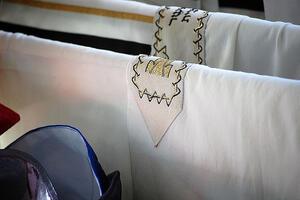A few months ago, I realized that I wanted to start wearing Tallit and Tefillin. Not because I had some grand change in ideology, but because I realized that doing so actually goes along with the ideology I’ve professed to have for quite some time.
I’ve always believed in egalitarianism, the idea that men and women should have the same obligations in regards to Judaism. However, until reading On the Ordination of Women as Rabbis by Rabbi Joel Roth, I hadn’t quite thought about the extent to which that belief should apply to everyday practice, including Mitzvot that are traditionally associated with only men. In his responsum, Rabbi Roth creates a justification for ordaining women as rabbis. In doing so, he discusses the fact that women are traditionally exempt from positive time-bound commandments, such as wearing Tallit (performed in the morning) because performing the Mitzvot would inhibit them from performing their duties at home. Roth brings up the idea that, for a woman who wishes for more to be expected of her than mothering, there could and should be another option: accepting full obligation of all Mitzvot upon herself, including positive time-bound ones. (His discussion of what this would entail and how it would affect people is quite long and nuanced, and worth a read.)
After reading his responsum, I realized that, in truth, I feel obligated to perform all Mitzvot–I see no reason why a male friend of mine should be obligated to perform Mitzvot that I am not. But with this realization came another one–that for years, I’ve been justifying my decision to not wear a Kippah, Tallit, or Tefillin with the word “comfort,” but that doing so is actually quite hypocritical of me. To put it simply: if I were a boy, I’d be wearing them, so why aren’t I?
And so, with that idea in mind, a few weeks ago I decided to try out a Tallit. At my school (or ex-school, as I’m about to graduate), we pray every morning, and so I asked one of our rabbis to teach me the blessing and how to put it on, and I wore it. I was immediately surprised at how comfortable it felt–wrapping myself up in the fabric made me feel warm and homey. It also just felt right–like I was differentiating between my day-to-day clothes and my prayer clothes and setting myself up to focus. That night my father took me to the local Judaica store in order to buy one of my own. We argued for a while about the color scheme, as I wanted to buy the plain blue, white, and silver Tallit that many boys wear at school, and he wanted me to buy a more feminine one. However, after both explaining my belief that if everyone’s obligated we can all wear the same type of Tallit and feeling the silky texture of a slightly more feminine but still simple white and blue Tallit, we settled on a beautiful Tallit that I have worn since that day.
I hadn’t had an opportunity to try Tefillin until yesterday thanks to many snow days and the end of school, but yesterday I woke up early, drove to school, came to Minyan, and was lucky enough to be taught by a peer how to put Tefillin on both my head and my arm. As a teacher had previously explained to me, they were very uncomfortable–they just felt weird. However, as he also explained, I found that weirdness to be very appealing–in his words, it had a kind of “shock effect.” Wearing the Tefillin on my head and my arm made me look and feel like I was not only praying, but like I was doing something overtly different from my normal life. Putting on and taking off Tefillin is somewhat laborious and time consuming–you can’t just immediately walk out into your normal life and move on like you can with a Tallit. I found that differentiation, that conscious effort, to be very powerful, and if I end up praying again on a daily basis (I’m graduating now), I’ll want to buy some and wear them (they’re pretty expensive.)
One of the best things about these two recent experiences was looking around the room and seeing both boys and girls wearing Tallit and Tefillin, comfortably (or uncomfortably, as the case may be) praying as a group. Instead of feeling different, I was one of them–obligated and fulfilling my obligation.
Originally posted at from the rib?, reposted with permission.







I'd still love resources, if you have them. However, I couldn't find an eco tallit anywhere so I made one from a scarf and shared the directions here.
I recently decided I wanted to wear a tallit, too. I really like the pretty ones and I love that they're feminine, but I really want it to be enviromentaly friendly, too, and I'm not sure how I feel about wearing wool (I'm vegetarian). Do you know of any resources for finding organic cotton, hemp, or a humane/organic wool tallit? I can't find anything online! (I might have to hire someone to make one from organic fabric for me.)
Thanks!
The other one--but it's also blue, white, and silver. It just has a few other colors mixed in, and is made of silk. I think it doesn't look overly feminine/different from men's tallitot, but I also felt really comfortable and even pretty in it.
So did you pick the blue, white and silver tallit, or the other one?